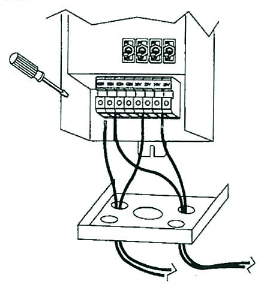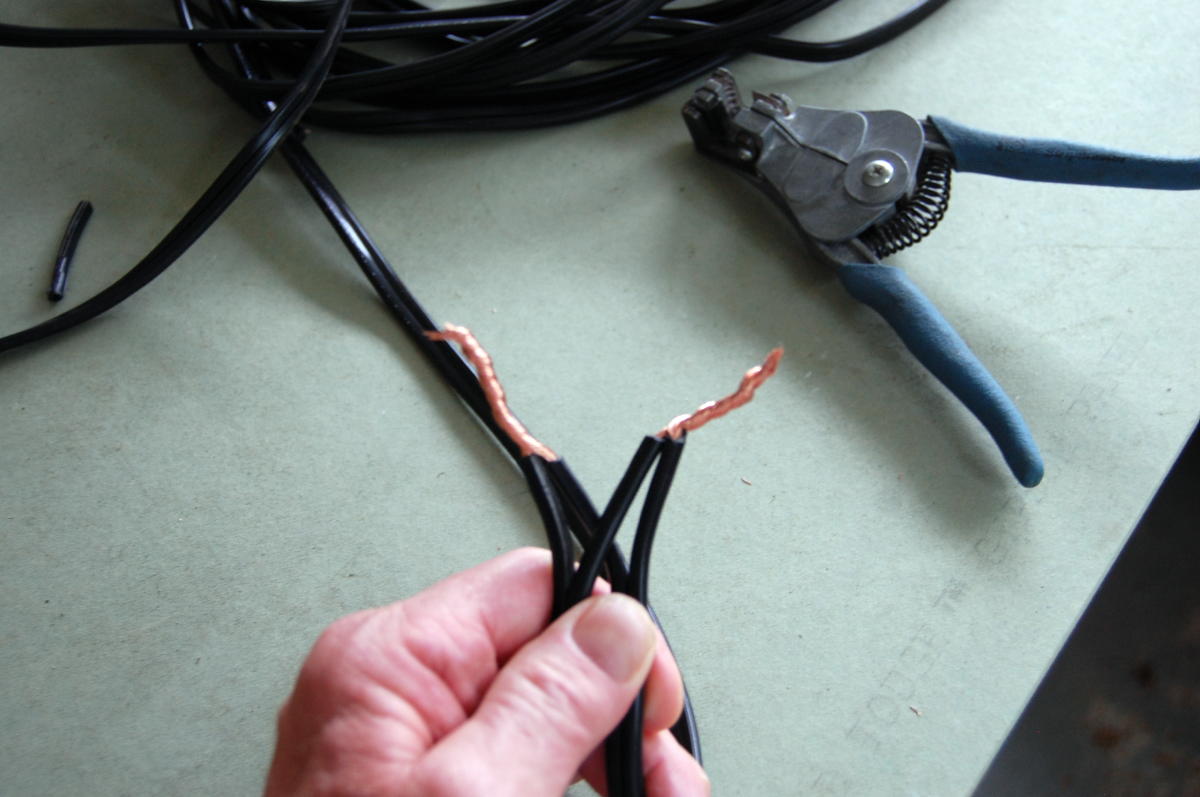Check Power To Transformer
Most transformers plugs into an outlet, usually 120 AC. Some transformers are wired directly from the wall mount.Verify the transformer is plugged or wired to a working power source of correct voltage.
If you don't have any electrical sensor, plug a light or power tool into the outlet. Make sure it works.
If the transformer has an ON/OFF switch, turn it on. (you may need to come back to this later to make sure it works. Switches get dirty, corroded, loose wires etc.)

If the transformer uses a photocell, timer, switch.
Photo cell, timer, switch failure is a common cause of transformer malfunction.
You should have an option to turn the transformer on manually. For now select manual operation, which means not to use photo cell or timer.
If no photocell, timer or switches;
Verify AC power to primary winding of transformer (primary winding is where plug wires connect to transformer), then go to step two.
This means you need to open up the cover, access the wire that feeds the transformer.
Note: At any time along the way, if you are apprehensive, a new transformer is the way to go. You get better design, clean contacts, and save time.
Verify that the Photocell, Timer, Switch Operate Properly
What we are looking for is switches in the circuit pass AC power to the primary winding of the transformer when they are supposed to.
If you do not have a photocell but switch or timer, wiring will be nearly the same. You will be looking to see AC power to the primary winding of the transformer.
- See if power is to the photocell. Check the wiring to and from from the photocell. Most transformers in place today get power to the primary winding through the photocell. This will be 120v AC.
- 2 wires attached to the photocell are power in and power out. The third wire is the ground. Disconnect the wires. Remove it for testing. Pay attention to condition of wires.
- Cover over the lens on the photocell with black tape. Photo cell lens Must be dark. A photocell is a light sensitive switch, and can take seconds to minutes to switch on.
- A multimeter can be used to ohm out the two power wires. The power wires will show no resistance when the photocell lens is taped over. The power wires will show High resistance when the photocell lens is NOT taped over.
- If the photocell is exposed to enough light at night, street lights etc. The black tape will reveal this.
Verify power supply is off to transformer. Non Contact Tester is handy here.
Photocell, Timer, Switch, are all switches.
If you are not able to ohm the circuit, You can jumper the power supply around the switches.
Transformers can also use a fuse and or a reset (circuit breaker) switch.
You can open any transformer and measure where voltage is or is not; and debug the circuit. All most never will the coils (the heavy part you can't fix) be the problem. In wet conditions with older installs, you may be better off buying a new transformer.
A Non Contact Tester saves lots of time.
You will still need a multimeter To accurately measure voltage, or ohm out a circuit, like a photocell.
Verify AC power to the primary winding of the transformer before moving to step 2.
Check Power To Transformer
Check Power Out From Transformer
Get Power From Secondary To Landscape Wire
About Wire Connections
Check Power Out From Transformer
If you have power to the transformer
- Verify power on the secondary side of the transformer. Looking for 12+ DC volts here.
- Use a voltage tester and check for power on the landscape wire. 12 - 15 volts DC is typical and what to look for.
If power is not detected on the landscape wire;
- Open the transformer for access to where the landscape wire is attached to the transformer output terminals.
- Check the connections. Check where the landscape wire connects to the transformer. Make sure the wire is strong and clean. If connections are old and or feeble, disconnect the landscape wire, cut off to wire looks new. Then strip enough to make a strong connection and re connect.
- Check for power anywhere on the secondary side of the transformer. This will be where wires from the transformer are connected to the output block where the landscape wire connects. You want to check for voltage at the transformer itself. Not farther down a wire. Could be a broken connection here.

If you DO NOT HAVE power at the secondary side of the transformer;
- Look for a Reset Switch or Circuit Breaker
- Look for a Fuse
If you still cannot detect power on the secondary side of the transformer, consider a new transformer.
If you consider a new modern transformer;
Also consider it is a good time to switch to LEDs. Most older fixtures can be equipped with retrofit LED bulbs. 1/5th wattage over halogen. There is an LED retrofit for almost all popular fixture and bulb types.
If you have power out the secondary side of the transformer, follow wires to the wire tap block.
When the wire tap block gets 12+ DC volts, we know the transformer works.
Verify DC power to the secondary side of the transformer before moving to step 3.
Newer Transformers like the one below might pay for themselves in the long run. Prices are right, parts are available. Usually just the photocell. The Malibu, replacement parts (photocells) are available. This model the photocell just plugs in. Another feature with this model transformer, the photocell is on a long cord. This allows the option mounting the transformer in locations where an attached photocell would not provide the desired results for dusk and dawn. The photocell on a cord, allows better placement for light detection.
Malibu 120 Watt Power Pack with Sensor and Weather Shield for Low Voltage Landscape Lighting Spotlight Outdoor Transformer 120V Input 12V Output 8100-9120-01
Check Power To Transformer
Check Power Out From Transformer
Get Power From Secondary To Landscape Wire
About Wire Connections
Get Power From Secondary To Landscape Wire
If you DO HAVE DC POWER on the secondary side of the transformer and no power to the landscape wire;
- Circuit to landscape wire connection block may be fused.
- Check wiring from secondary to landscape wire block.
- Some higher end transformers feature timer and photocell on secondary side multi tap. Check the Photo Cell is working, may be fused also.
Verify DC power landscape wire block. 12+ volts is what to look for.
When DC 12+ volts is verified on the output block and wire, check for voltage at the nearest light. Keep in mind bulbs and fixtures fail. Most common problem is poor wire connections.
Verify DC power on the output block and wire before moving to step 4.
Check Power To Transformer
Check Power Out From Transformer
Get Power From Secondary To Landscape Wire
About Wire Connections
STEP 4
About Wire ConnectionsThe quick connectors which accompany most outdoor low voltage fixtures are designed such that moisture gets in the wire. First thing we do on a repair is remove the connectors, strip the wire back 1 1/2 inches. Twist a solid connection and use outdoor wire nuts. If the wire is in an area where connections are challenged, then take time to tape it well. You will be surprised how a really good connections can affect bulb life. Even LEDs.
Wire Connections Make the Difference
Landscape light wire sits in moisture. Quick connects do not last. The connection area receives moisture, connection becomes poor. The new mechanical wire strippers allow the following connection be easy and fast. If it seems like over kill; at least you know your connections are strong and will last.

Cutting off the crimp connector.
This connector came on the fixture. It uses piercing the landscape wire to hit the coper braid in the wire.
it relies on a thin tooth to enter the wire where the copper connector is. Overall a connection is made.
The hand strip and hand twist is many times more robust and reliable.
Strip twist, and tape or water proof wire nut connectors. Best to strip at least 1 1/2 inch. Twist the wires neat and tight as possible. Tape real well. With wire nuts, snip the twisted copper to length.
New style wire stripper makes the work of stripping heavy wire easier.
The unit works well on larger wire, but presents issues when attempting to strip stranded wire 22 gauge and smaller.
Most fixtures connection wire is a little thin for this size stripper.
IRWIN VISE-GRIP 2078300 Self-Adjusting Wire Stripper, 8"

Landscape wire is stranded
Twist wire clockwise.
Twist individually before connecting with another wire.
Twisted together, this make for a tough connection. Wire laid out in garden areas gets some abuse from general landscape maintenance.
Using wire nuts, snip twisted connection to length for wire nut. Use the hand stripped, hand twisted connections for a robust install. Wire nuts don't twist the wire properly by them self. The procedure shown here will save lots of maintenance time in future.

Snip the twisted pair to length for wire nuts.
Best light output from your installation of outdoor lighting, depends on strong and reliable connections.

Your low voltage landscape wire lays in the ground, where moisture collects.
Far better than the quick connects; better connection that will hold up over time.
King Innovation 62225 DryConn Outdoor Electrical Wire Connector 20/Bag, Aqua/Red




